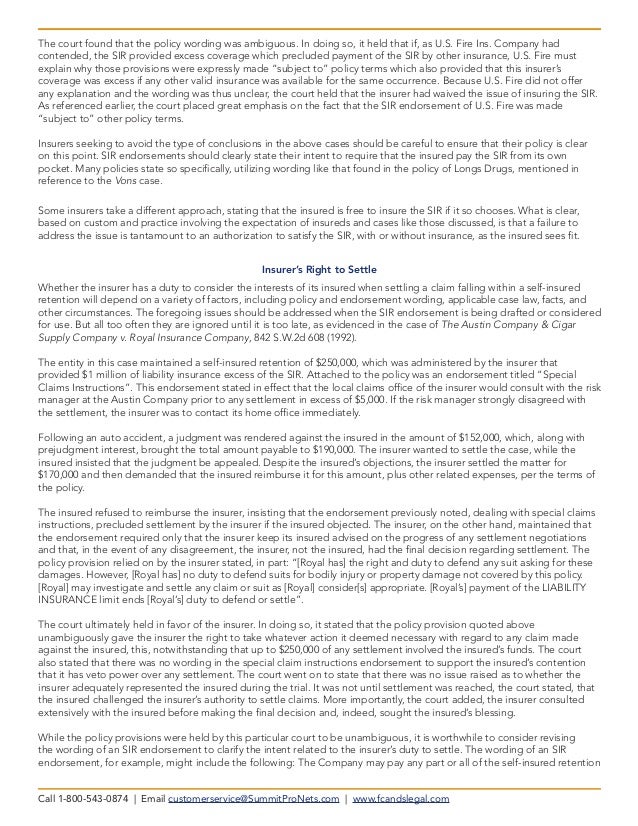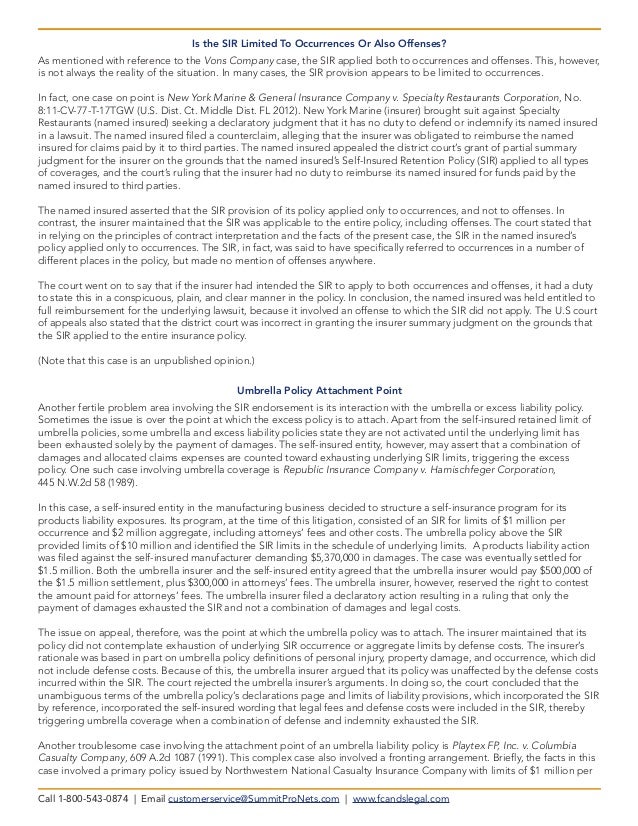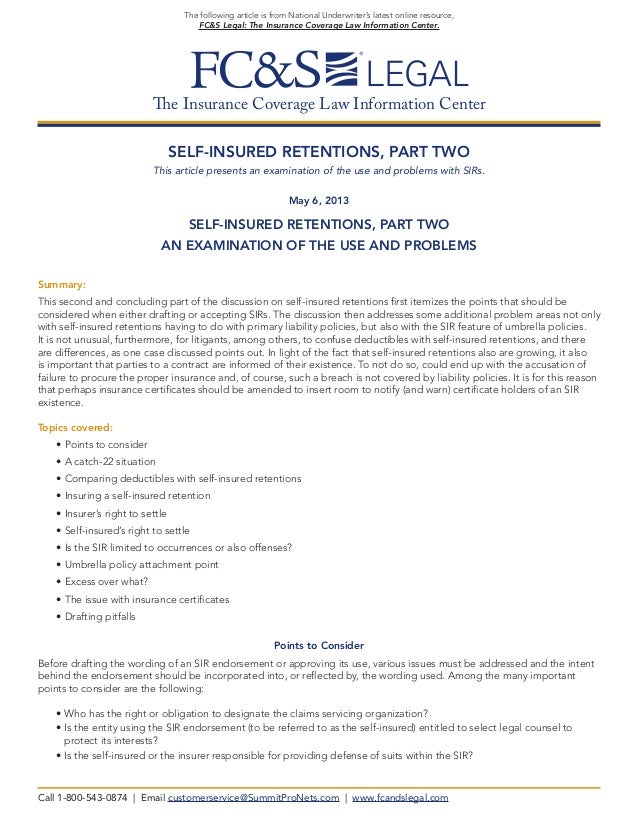What is self insured retention Idea
Home » Trend » What is self insured retention IdeaYour What is self insured retention images are available. What is self insured retention are a topic that is being searched for and liked by netizens now. You can Find and Download the What is self insured retention files here. Get all royalty-free photos.
If you’re looking for what is self insured retention images information linked to the what is self insured retention interest, you have pay a visit to the right site. Our site frequently gives you hints for downloading the maximum quality video and image content, please kindly search and find more enlightening video content and images that match your interests.
What Is Self Insured Retention. Let’s say you have a liability policy that protects against your company going through a lawsuit. Thus, under a policy written with a self insured retention provision, the insured (rather than the insurer) would pay defense and/or indemnity costs associated with a claim. It is the amount of money that the policyholder (the person or company who purchased the policy of insurance) must pay to defend or resolve a claim for damages before the insurer steps in and provides coverage under the policy. A self insured retention is similar to a deductible, but you pay the self insured retention amount first before the insurance company begins paying.
 SelfInsured Retentions Part 2 An Examination of the Uses From slideshare.net
SelfInsured Retentions Part 2 An Examination of the Uses From slideshare.net
The insurer provides immediate defense, pays for any losses incurred and then collects reimbursement from the policyholder after the claims is closed, up to the deductible amount. The self insured retention would only apply when a loss is excluded from coverage under the primary policy. The sir can be one tactic. With a deductible, the insured notifies the insurer when there is a claim. The single largest problem is whether the insured has a large (or small enough) case exposure, not to just understand and limit damages but more critically project and manage the number of cases, to. Self insured retention (sir) is similar to primary insurance.
While some view these terms as essentially being interchangeable due to their overall concept being similar, there are.
As premiums increase in the commercial habitational sector, an increasing number of organizations seek alternatives to reduce insurance costs. With a deductible, the insured notifies the insurer when there is a claim. This is the amount of money that you are required to pay, per claim, before the insurance company will start paying. The insurer is not obligated to pay claims until the sir has been satisfied. Example john slips and falls on a substance on the floor of a publix. The self insured retention would only apply when a loss is excluded from coverage under the primary policy.
 Source: transadj.com
Source: transadj.com
An organisation and an insurer both have an interest that it is set in an appropriate amount so that coverage can function as intended. It is the amount of money that the policyholder (the person or company who purchased the policy of insurance) must pay to defend or resolve a claim for damages before the insurer steps in and provides coverage under the policy. That means that the insured who wishes to purchase a commercial umbrella needs to have either an underlying liability policy, such as a commercial general liability, a business auto liability or an employers� liability policy, or carry a sir of a certain amount. The self insured retention is the amount of the loss the insured must pay before the umbrella policy would be required to respond. A self insured retention is similar to a deductible, but you pay the self insured retention amount first before the insurance company begins paying.
 Source: youtube.com
Source: youtube.com
The sir can be one tactic. The sir can be one tactic. If implemented correctly, it will encourage them to participate in what is a mutually beneficial relationship. Large businesses often choose a liability policy that includes an sir because they want more control over the claims payment. As premiums increase in the commercial habitational sector, an increasing number of organizations seek alternatives to reduce insurance costs.
 Source: thebalancesmb.com
Source: thebalancesmb.com
And some of you didn�t know there was a difference between sirs and deductibles. This is the amount of money that you are required to pay, per claim, before the insurance company will start paying. The insurer provides immediate defense, pays for any losses incurred and then collects reimbursement from the policyholder after the claims is closed, up to the deductible amount. If implemented correctly, it will encourage them to participate in what is a mutually beneficial relationship. Self insured retention is seen in commercial general.
 Source: wsandco.com
Source: wsandco.com
Thus, under a policy written with a sir provision, the insured (rather than the insurer) would pay defense and/or indemnity costs associated with a claim until the sir. While some view these terms as essentially being interchangeable due to their overall concept being similar, there are. As premiums increase in the commercial habitational sector, an increasing number of organizations seek alternatives to reduce insurance costs. The sir can be one tactic. It is the amount of money that the policyholder (the person or company who purchased the policy of insurance) must pay to defend or resolve a claim for damages before the insurer steps in and provides coverage under the policy.
 Source: slideshare.net
Source: slideshare.net
If implemented correctly, it will encourage them to participate in what is a mutually beneficial relationship. The self insured retention is the amount of the loss the insured must pay before the umbrella policy would be required to respond. If implemented correctly, it will encourage them to participate in what is a mutually beneficial relationship. The single largest problem is whether the insured has a large (or small enough) case exposure, not to just understand and limit damages but more critically project and manage the number of cases, to. While some view these terms as essentially being interchangeable due to their overall concept being similar, there are.
 Source: slideshare.net
Source: slideshare.net
Thus, under a policy written with a sir provision, the insured (rather than the insurer) would pay defense and/or indemnity costs associated with a claim until the sir. If implemented correctly, it will encourage them to participate in what is a mutually beneficial relationship. It is the amount of money that the policyholder (the person or company who purchased the policy of insurance) must pay to defend or resolve a claim for damages before the insurer steps in and provides coverage under the policy. When a commercial umbrella policy is used to fill in coverage gaps left by underlying policies, there aren ’t any primary policies that can meet an underlying limit. That means that the insured who wishes to purchase a commercial umbrella needs to have either an underlying liability policy, such as a commercial general liability, a business auto liability or an employers� liability policy, or carry a sir of a certain amount.
 Source: thinkccig.com
Source: thinkccig.com
This is the amount of money that you are required to pay, per claim, before the insurance company will start paying. With a deductible, the insured notifies the insurer when there is a claim. Thus, under a policy written with a sir provision, the insured (rather than the insurer) would pay defense and/or indemnity costs associated with a claim until the sir. When a policy includes an sir, the insured is generally responsible for paying claims that fall within the retention. As premiums increase in the commercial habitational sector, an increasing number of organizations seek alternatives to reduce insurance costs.
 Source: hisnv.com
Source: hisnv.com
Self insured retention (sir) is similar to primary insurance. Self insured retention is seen in commercial general. The self insured retention is the amount of the loss the insured must pay before the umbrella policy would be required to respond. If you typically face more than 20 to 25 claims per year, your. An organisation and an insurer both have an interest that it is set in an appropriate amount so that coverage can function as intended.
 Source: youtube.com
Source: youtube.com
If you typically face more than 20 to 25 claims per year, your. That means that the insured who wishes to purchase a commercial umbrella needs to have either an underlying liability policy, such as a commercial general liability, a business auto liability or an employers� liability policy, or carry a sir of a certain amount. A self insured retention is similar to a deductible, but you pay the self insured retention amount first before the insurance company begins paying. Self insured retention (sir) is similar to primary insurance. The single largest problem is whether the insured has a large (or small enough) case exposure, not to just understand and limit damages but more critically project and manage the number of cases, to.
 Source: reshield.com
Source: reshield.com
The insurer provides immediate defense, pays for any losses incurred and then collects reimbursement from the policyholder after the claims is closed, up to the deductible amount. Self insured retention (sir) is similar to primary insurance. A self insured retention is similar to a deductible, but you pay the self insured retention amount first before the insurance company begins paying. The self insured retention is the amount of the loss the insured must pay before the umbrella policy would be required to respond. Thus, under a policy written with a self insured retention provision, the insured (rather than the insurer) would pay defense and/or indemnity costs associated with a claim.
 Source: slideshare.net
Source: slideshare.net
An organisation and an insurer both have an interest that it is set in an appropriate amount so that coverage can function as intended. Self insured retention (sir) is similar to primary insurance. The self insured retention would only apply when a loss is excluded from coverage under the primary policy. And some of you didn�t know there was a difference between sirs and deductibles. The insurer provides immediate defense, pays for any losses incurred and then collects reimbursement from the policyholder after the claims is closed, up to the deductible amount.
 Source: alignedinsurance.com
Source: alignedinsurance.com
The single largest problem is whether the insured has a large (or small enough) case exposure, not to just understand and limit damages but more critically project and manage the number of cases, to. An umbrella policy�s coverage is triggered when the limits of the underlying insurance have been exhausted. The single largest problem is whether the insured has a large (or small enough) case exposure, not to just understand and limit damages but more critically project and manage the number of cases, to. Thus, under a policy written with a sir provision, the insured (rather than the insurer) would pay defense and/or indemnity costs associated with a claim until the sir. As premiums increase in the commercial habitational sector, an increasing number of organizations seek alternatives to reduce insurance costs.
 Source: youtube.com
Source: youtube.com
Thus, under a policy written with a self insured retention provision, the insured (rather than the insurer) would pay defense and/or indemnity costs associated with a claim. The self insured retention would only apply when a loss is excluded from coverage under the primary policy. That means that the insured who wishes to purchase a commercial umbrella needs to have either an underlying liability policy, such as a commercial general liability, a business auto liability or an employers� liability policy, or carry a sir of a certain amount. An umbrella policy�s coverage is triggered when the limits of the underlying insurance have been exhausted. When a policy includes an sir, the insured is generally responsible for paying claims that fall within the retention.
 Source: lifechangingsystem1.blogspot.com
Source: lifechangingsystem1.blogspot.com
If you typically face more than 20 to 25 claims per year, your. An umbrella policy�s coverage is triggered when the limits of the underlying insurance have been exhausted. Large businesses often choose a liability policy that includes an sir because they want more control over the claims payment. The self insured retention would only apply when a loss is excluded from coverage under the primary policy. With a deductible, the insured notifies the insurer when there is a claim.
 Source: slideshare.net
Source: slideshare.net
That means that the insured who wishes to purchase a commercial umbrella needs to have either an underlying liability policy, such as a commercial general liability, a business auto liability or an employers� liability policy, or carry a sir of a certain amount. Large businesses often choose a liability policy that includes an sir because they want more control over the claims payment. This is the amount of money that you are required to pay, per claim, before the insurance company will start paying. Self insured retention is seen in commercial general. Thus, under a policy written with a sir provision, the insured (rather than the insurer) would pay defense and/or indemnity costs associated with a claim until the sir.
 Source: libertymutualcanada.com
Source: libertymutualcanada.com
If implemented correctly, it will encourage them to participate in what is a mutually beneficial relationship. That means that the insured who wishes to purchase a commercial umbrella needs to have either an underlying liability policy, such as a commercial general liability, a business auto liability or an employers� liability policy, or carry a sir of a certain amount. The self insured retention is the amount of the loss the insured must pay before the umbrella policy would be required to respond. Large businesses often choose a liability policy that includes an sir because they want more control over the claims payment. If implemented correctly, it will encourage them to participate in what is a mutually beneficial relationship.
 Source: youtube.com
Source: youtube.com
If you typically face more than 20 to 25 claims per year, your. Self insured retention is seen in commercial general. The self insured retention would only apply when a loss is excluded from coverage under the primary policy. A self insured retention is similar to a deductible, but you pay the self insured retention amount first before the insurance company begins paying. The sir can be one tactic.
 Source: slideshare.net
Source: slideshare.net
Example john slips and falls on a substance on the floor of a publix. Self insured retention is seen in commercial general. The sir can be one tactic. Example john slips and falls on a substance on the floor of a publix. Let’s say you have a liability policy that protects against your company going through a lawsuit.
This site is an open community for users to do sharing their favorite wallpapers on the internet, all images or pictures in this website are for personal wallpaper use only, it is stricly prohibited to use this wallpaper for commercial purposes, if you are the author and find this image is shared without your permission, please kindly raise a DMCA report to Us.
If you find this site beneficial, please support us by sharing this posts to your preference social media accounts like Facebook, Instagram and so on or you can also save this blog page with the title what is self insured retention by using Ctrl + D for devices a laptop with a Windows operating system or Command + D for laptops with an Apple operating system. If you use a smartphone, you can also use the drawer menu of the browser you are using. Whether it’s a Windows, Mac, iOS or Android operating system, you will still be able to bookmark this website.

Category
Related By Category
- Vicarious liability insurance definition Idea
- Staples insurance information
- Youi car insurance claim Idea
- T mobile insurance for iphone x information
- Shelter insurance fayetteville ar information
- Roger smith insurance Idea
- Scotia insurance eastern caribbean limited Idea
- Toronto condo insurance average rates information
- Sell life insurance policy calculator Idea
- Velox insurance hiram information